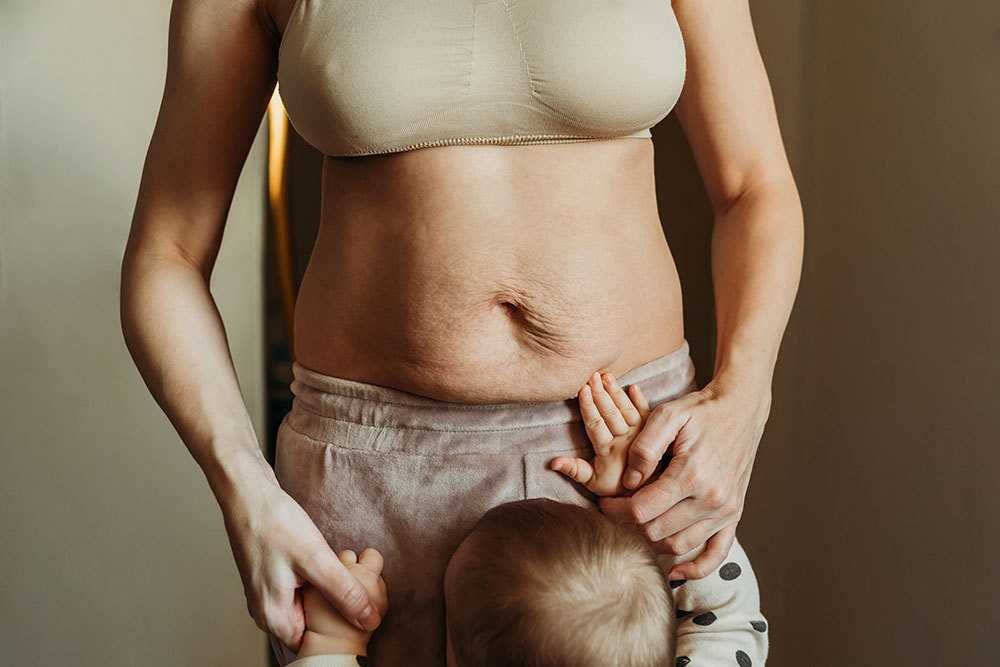Why Toxic Bounce-Back Culture Hurts New Moms

Embracing the amazing body you have now instead of longing for your pre-baby frame.
Expert: Rachel Trotta, NASM, ACE
The night after I gave birth to my daughter, I snapped a selfie of myself in the hospital room mirror. That photo captures a special moment; my pure relief at having ushered a new life safely into the world glows through my peaceful smile, my relaxed posture, and—yes—my post-baby bump.
As a personal trainer who specializes in women’s health and the perinatal period, I was well aware that my “bump” would remain for at least a few weeks after delivering the baby, due to the position of the uterus after birth. Nevertheless, I was surprised at how hugely pregnant I looked, even though my new baby was snoozing in the bassinet at my bedside.
Over the next few weeks, my belly began to retreat to its former proportions, but my confidence in my body also began to shrink. I was not prepared for the squishiness, or for the fact that my linea nigra stayed put for longer than I expected. Or that my breasts—which had already been curvaceous pre-baby—were now bursting out of my bras in a way that I didn’t find particularly sexy. Not to mention, as a personal trainer, I felt pressure to look not just average, but amazing. And right away, please.
Social Media and Bounce-Back Culture
This urgency I felt was because I was holding myself to the synthetic standard presented by social media, where I saw women, who had been filtered into my feed from all over the world, looking impossibly fit with their newborns.
Even as a personal trainer with a solid understanding of birth recovery, I couldn’t help but measure my progress against other women who had given birth around the same time as me, particularly the ones who had made jaw-dropping “snapback” transformations. The pressure to recapture my prepregnancy physique added one more anxiety to the many other stresses I was experiencing that are endemic to new motherhood.
Bounce-back culture (sometimes also called snapback culture), which celebrates women who quickly look like their prepregnancy selves postpartum, flourishes in the climate of social media—where it can be difficult to distinguish reality from illusion under the best of circumstances. The postpartum period is a time when we are particularly vulnerable to body dissatisfaction triggers, and it’s common for new moms to rely heavily on social media for adult connection.
In fact, one study projects that 44% of women increase their Facebook use after having a baby. Another study revealed that when new moms compare themselves to what they see online, they experience higher rates of postpartum depression. The pressure to “bounce back” is real, and it can be damaging.
After realizing how much social media was influencing my feelings and body image during the postpartum period, I took a step back to reassess. Eventually, I came to realize how important it is to reframe the fourth trimester and to stay focused on the aspects of recovery that matter so much more than fitting into pre-baby jeans.
Honoring Unique Experiences
Estrogen takes a nosedive after pregnancy, which can affect everything from weight management to wound healing to sexual desire. It takes time—often months—for hormones to regulate back to normal circulating levels after having a baby, even without breastfeeding.
Many women don’t realize how differently new mothers can respond to the hormonal cocktail of the postpartum period. How each woman responds to these varying hormone levels can be extremely individual, and common clichés about post-pregnancy weight loss simply don’t apply to everyone. For example, despite increasing metabolic output, breastfeeding doesn’t always result in effortless weight loss postpartum.
We can’t assume that our fourth trimester and birth recovery will be just like someone else’s. Every postpartum journey is unique, and by acknowledging and understanding this important truth, you will set yourself up for a more positive experience.

Fueling Physical Recovery
Too often, we think of recovery too literally, as if only a C-section or a serious tear requires recuperation. In reality, “tissue recovery” includes everything from wound healing to pelvic floor strengthening to diastasis recti closure.
Even an uncomplicated delivery after a healthy pregnancy is a trauma that requires convalescence, as well as the fuel to accomplish it—and food equals fuel.
When insufficient calories are coming into the body, we simply don’t have the raw materials to create new tissue and remodel the areas affected by pregnancy and birth. This is true for anyone in the postpartum period, but it’s especially significant for breastfeeding women who, in addition to healing physically, also need to establish and maintain a milk supply for their baby.
Simply put, dieting to lose weight during the fourth trimester isn’t a good idea. It can ultimately have the opposite of the intended effect because it could slow down recovery, compromise the body’s ability to build lean muscle, and possibly create issues with breastfeeding and pelvic floor recovery.
Instead of cutting calories or food groups postpartum, focus on fueling your body well with regular meals and nourishing foods like oatmeal, fruit, beans, nuts, chicken, eggs, berries, and more.
Separating Exercise From Weight Loss
It’s long past time to reframe how we see postpartum exercise. Instead of looking at it as a means to “lose the baby weight,” we should consider it a form of self-care.
Now, as a new parent, exercise is an opportunity to get some much-needed time to take care of ourselves in more ways than one. Stroller walks give us fresh air and sunlight. Strength training makes life with a baby in tow easier. Pelvic floor exercises can prevent unwanted (or embarrassing) symptoms. Mommy-and-me classes provide social support.
But most importantly, physical activity provides tremendous mental health benefits in the postpartum period, reducing the risk of developing postpartum depression and anxiety.
New recommendations suggest that the six-week check-up is too long to wait to begin many types of exercise, like walking and pelvic floor exercises. But, conversely, it’s too soon to resume other activities that have traditionally been greenlit at six weeks, like running, which could result in symptoms like chronic urine leakage, pelvic discomfort, and lower back pain.
Ultimately, the postpartum period is a unique time to cultivate gentle lifestyle balance, prioritizing movement and fitness without falling into the trap of using exercise to lose the baby weight.
Intense exercise can wait. In the meantime, light-to-moderate physical activity will pave the path back to more vigorous workouts, as well as provide immediate, enjoyable benefits—both physically and mentally.
Embracing the Body You Have
Sometimes, a desire for postpartum weight loss is simply a longing for normalcy. This is completely understandable because the transition to being a mama is intense, and it can be easy to lapse into daydreams of when our bodies (and our time) were our own.
But it’s vital to remember that, even with an ideal fitness and nutrition program, we’re not completely erasing the effects of pregnancy—we’re integrating pregnancy into our physical experience. No matter how much exercise we do, our bodies will forever hold the memory of pregnancy and birth.
Building confidence in your mom-bod often means coming to terms with having a fitter physique with looser skin, wider hips, or larger (or smaller) breasts. It also may mean buying clothing that fits this chapter of life, including new sports bras and workout gear. Investing in properly fitting clothing that’s a larger size doesn’t signify “letting ourselves go,” it’s an assertion of our worthiness of self-care.
Embracing the body you have means doing the things you want to do—like confidently wearing a swimsuit, or being in photos—without shame over normal postpartum changes like a rounder belly, stretch marks, or a C-section scar.
For me, this was a powerful shift in my thinking. Once I stopped trying to recreate my exact prepregnancy size and weight, I began to make real progress in my postpartum recovery, and I became even stronger, fitter, and faster than I was before I had my daughter.
Cultivating Critical Thinking About Social Media
Finally, it’s important to remember that visual platforms like Instagram encourage us to not only curate our self-presentation but also to compare our insides to other people’s outsides. This leaves us contrasting our stark realities (often at their worst) with carefully crafted and staged online content, usually with depressing results.
Fortunately, more and more new moms—even celebrities—are beginning to present themselves on social media platforms with honesty and humor. On Instagram, for example, we’re scrolling through photos featuring stretch marks, stories of postpartum depression, C-section scars, and even more transparency about post-pregnancy cosmetic procedures.
Still, it’s key to keep in mind that, in many cases, we’re not really friends with these people, and we don’t know the whole story behind posts—especially the ones that trigger jealousy or insecurity.
This is why it’s so important to turn off your phone and engage in human interaction during the postpartum period (and anytime, really). Investing in real-time, in-person relationships can be immensely helpful, allowing us to see and speak with other new moms up close. I remember when my daughter was a newborn how much of a relief it was to see other people’s babies cry—as this was never pictured on social media.
Self-care activities like going to a new mom’s support group, a mommy-and-me yoga class, or even a friend’s house for coffee can encourage a more realistic outlook on new mom life, as well as physical postpartum recovery.
Today, my daughter is no longer snug in a bassinet. She’s 2 years old and doing incredible things like using the potty and forming sentences. But I still carry the lessons I learned during my postpartum recovery. Because I made the effort to focus on what mattered as my body healed from pregnancy and delivery, I can honestly say that I’ve never appreciated or respected my body more than I do today.
Resisting the pressure of snapback culture—including letting our post-baby bumps simply be, instead of trying to diet or plank them away immediately—is one of the kindest things that we can do for ourselves in the fourth trimester and beyond. So let’s cut ourselves some slack, enjoy our new babies, and focus on self-care, with the comfort of knowing that the postpartum period won’t last forever.







